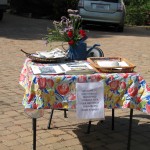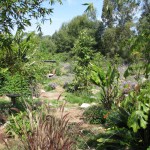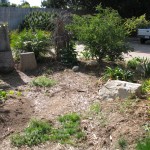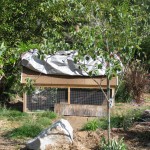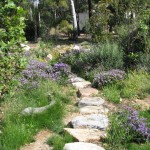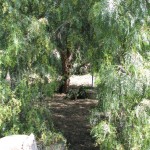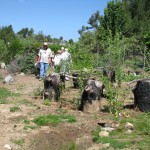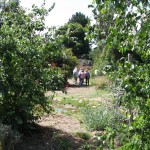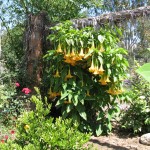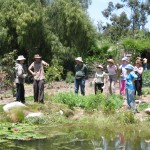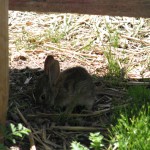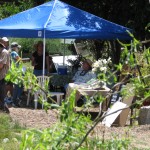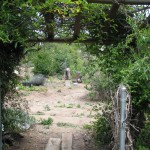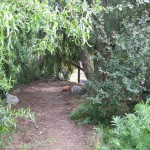Reptiles and Amphibians
- Animals, Birding, Chickens, Gardening adventures, Heirloom Plants, Humor, Permaculture and Edible Forest Gardening Adventures, Photos, Ponds, Reptiles and Amphibians
Happy Easter!
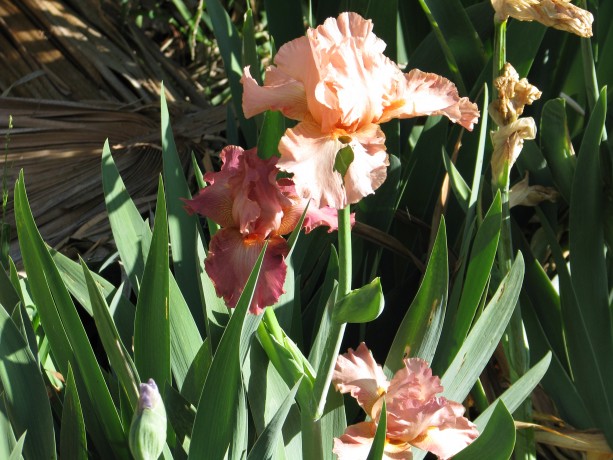
Heirloom irises from my good friend Jean are blooming. 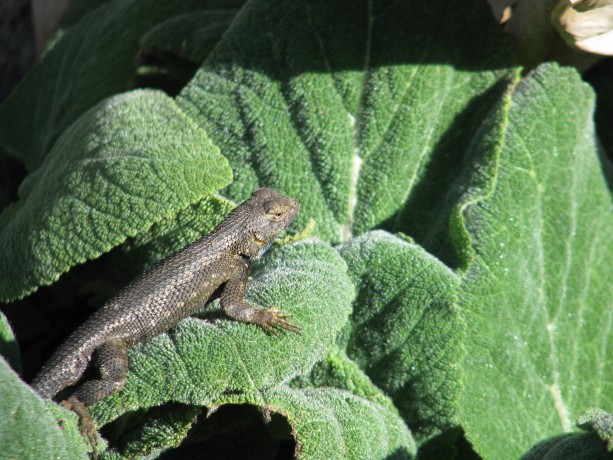
A Western fence lizard suns and guards his territory atop a clary sage leaf. See the flash of blue under his chin to attract the ladies? 
This green calla lily is gorgeous. 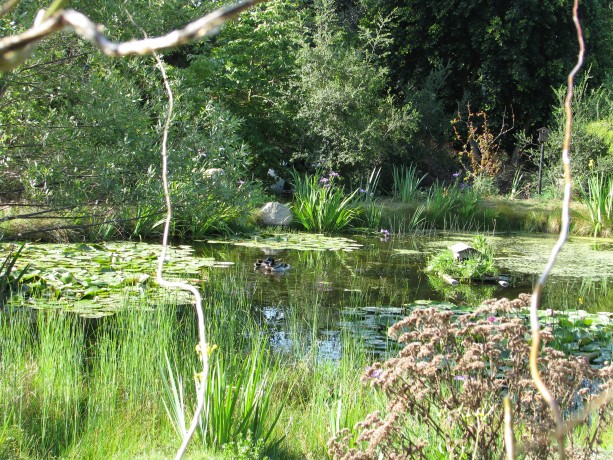
Framed by curly willow from the Withy Bird Hide, two drakes swim in the pond on Easter morning. 
Sweet peas are still blooming. They hold the permaculture precept of everything having three purposes: they are nitrogen fixers, they are edible, and they are gorgeous. 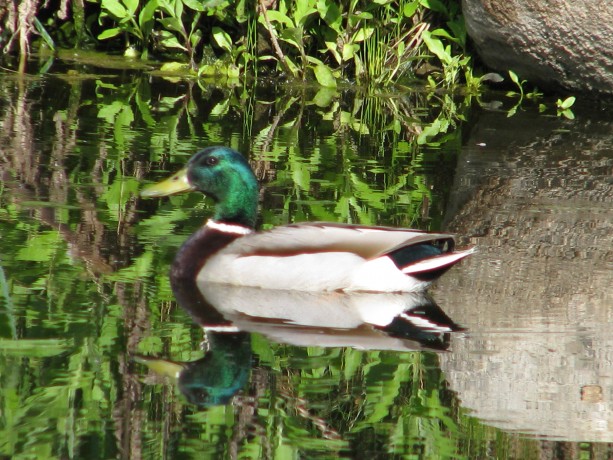
A fancy drake who showed up this morning. 
The irises surrounding the pond are spectacular right now. Blue, dark blue and yellow flag. 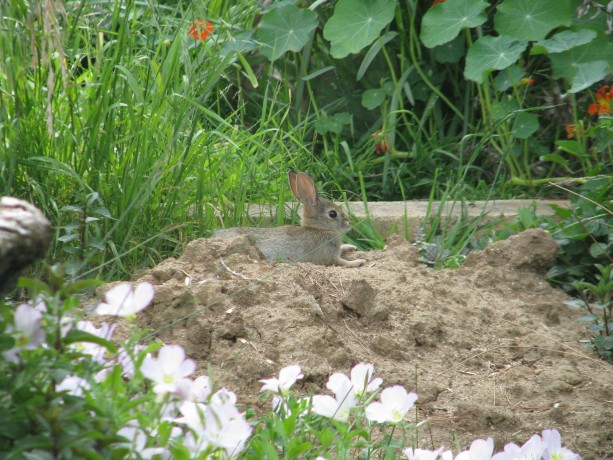
Baby bunny has been growing out his ears. He’s enjoying a warm dirt bath. 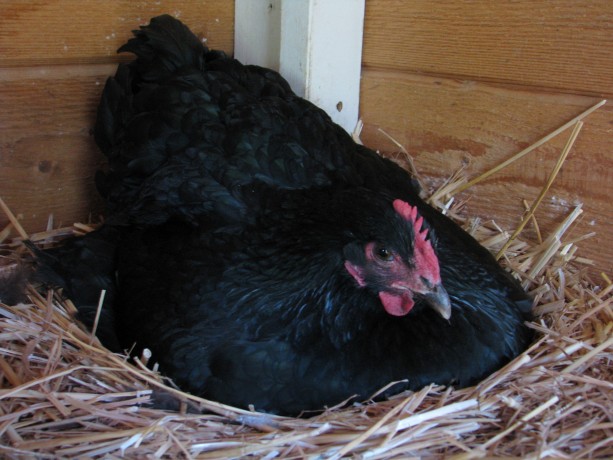
Mulan has gone broody. Such a large chicken puddles out over the wooden egg she’s trying to hatch. We’re feeding her an oatmeal mixture in a dish because she won’t come down during the day. 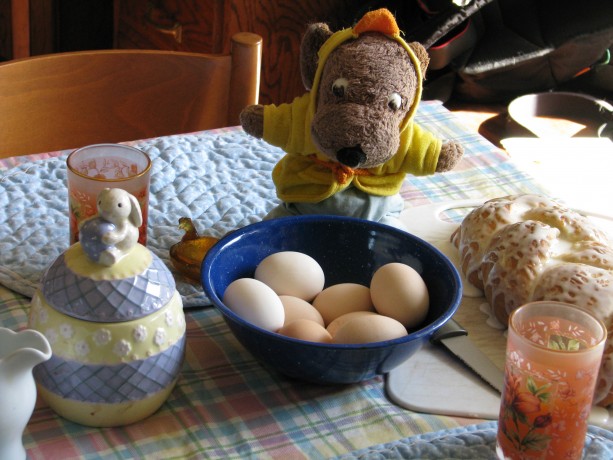
Easter breakfast. Hard boiled eggs, naturally colored by our hens, fresh tangerine juice, our traditional stollen from my mother’s recipe, and Peanut in his chicky robe ready to launch into the food. Peanut doesn’t act his age, of about 40+ years, but has traveled and been photographed extensively in Europe and Ecuador. Its nice that he wakes up for holidays. - Animals, Bees, Birding, Chickens, Cob, Compost, Composting toilet, Fungus and Mushrooms, Gardening adventures, Health, Heirloom Plants, Hiking, Humor, Living structures, Natives, Natural cleaners, Other Insects, Permaculture and Edible Forest Gardening Adventures, Pets, Photos, Ponds, Predators, Quail, Rain Catching, Reptiles and Amphibians, Seeds, Soil, Water Saving, Worms
Finch Frolic Facebook!
Thanks to my daughter Miranda, our permaculture food forest habitat Finch Frolic Garden has a Facebook page. Miranda steadily feeds information onto the site, mostly about the creatures she’s discovering that have recently been attracted to our property. Lizards, chickens, web spinners and much more. If you are a Facebook aficionado, consider giving us a visit and ‘liking’ our page. Thanks!
- Animals, Bees, Birding, Compost, Fruit, Fungus and Mushrooms, Gardening adventures, Herbs, Hugelkultur, Natives, Other Insects, Permaculture and Edible Forest Gardening Adventures, Ponds, Predators, Rain Catching, Reptiles and Amphibians, Seeds, Soil, Vegetables, Water Saving, Worms
The Mulberry Guild
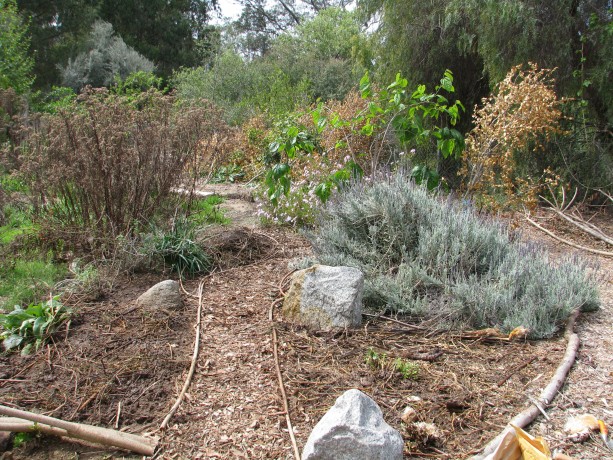
The renovated and planted mulberry guild. One of our larger guilds has a Pakistani mulberry tree that I’d planted last spring, and around it had grown tomatoes, melons, eggplant, herbs, Swiss chard, artichokes and garlic chives.
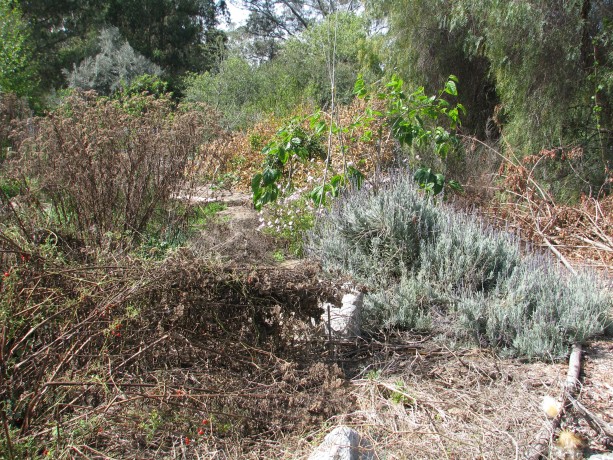
Mulberry guild with last year’s plant matter and unreachable beds. This guild was too large; any vegetable bed should be able to be reached from a pathway without having to step into the bed. Stepping on your garden soil crushes fungus and microbes, and compacts (deoxygenates) the soil. So of course when I told my daughter last week that we had to plant that guild that day, what I ended up meaning was, we were going to do a lot of digging in the heat and maybe plant the next day. Most of my projects are like this.
Lavender, valerian, lemon balm, horehound, comfrey and clumping garlic chives were still thriving in the bed. Marsh fleabane, a native, had seeded itself all around the bed and had not only protected veggies from last summer’s extreme heat, but provided trellises for the current tomatoes.
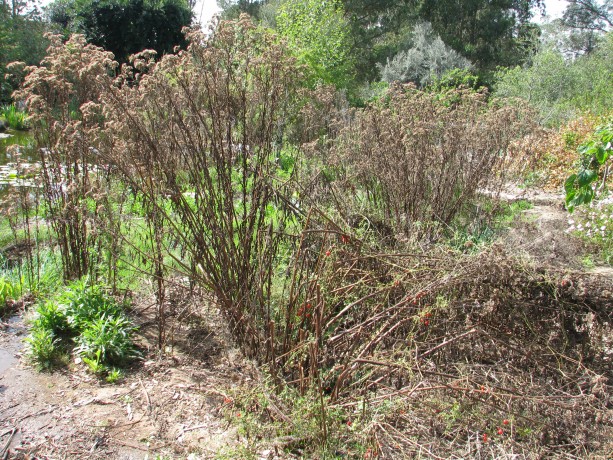
Fleabane stalks from last year, with new growth coming from the roots. Marsh fleabane is an incredible lure for hundreds of our tiny native pollinators and other beneficial insects. Lots of lacewing eggs were on it, too. The plants were coming up from the base, so we cut and dropped these dead plants to mulch the guild.
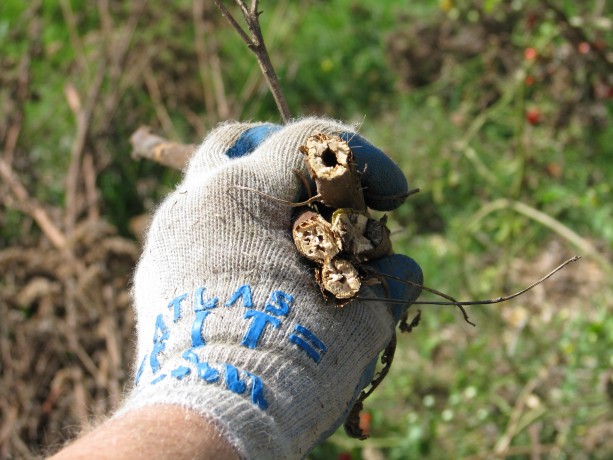
The stalks of fleabane are hollow… perfect homes for small bees! The stems were hollow and just the right size to house beneficial bees such as mason bees. This plant is certainly a boon for our first line of defense, our native insects.
We also chopped and dropped the tomato vines. Tomatoes like growing in the same place every year. With excellent soil biology – something we are still working on achieving with compost and compost teas – you don’t have to rotate any crops.

Slashed and dropped tomato and fleabane. We had also discovered in the last flood that extra water through this heavy clay area would flow down the pathway to the pond, often channeled there via gopher tunnels.
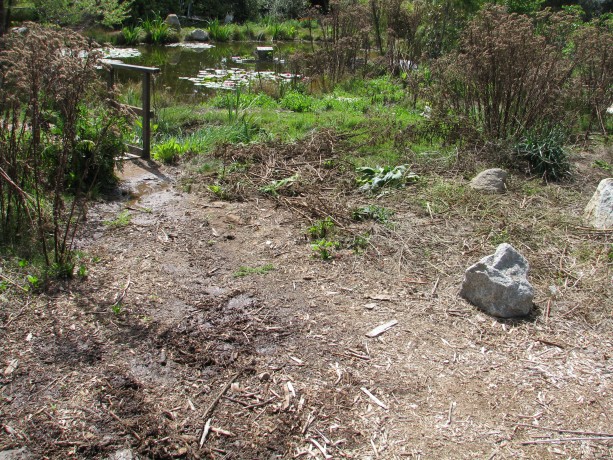
The pathway is a water channel during heavy rains. It needs fixing. We decided to harvest that water and add water harvesting pathways to the garden at the same time. We dug a swale across the pathway, perpendicular to the flow of water, and continued the swale into the garden to a small hugel bed.

Swale dug on contour through the pathway and across the guild. Hugelkultur means soil on wood, and is an excellent way to store water in the ground, add nutrients, be rid of extra woody material and sequester carbon in the soil. We wanted the bottom of the swale to be level so that water caught on the pathway would slowly travel into the bed and passively be absorbed into the surrounding soil. We used our wonderful bunyip (water level).
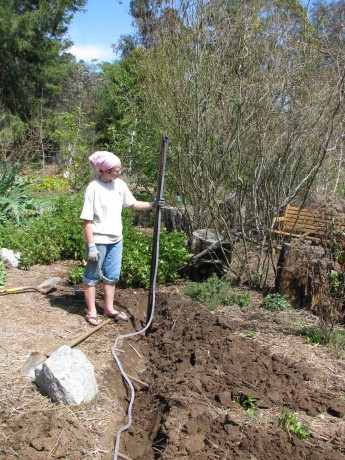
Using a bunyip to make the bottom of the swale level. Water running into the path will now be channeled through the guild. Because of the heavy clay involved we decided to fill the swale with woody material, making it a long hugel bed. Water will enter the swale in the pathway, and will still channel water but will also percolate down to prevent overflow. We needed to capture a lot of water, but didn’t want a deep swale across our pathway. By making it a hugel bed with a slight concave surface it will capture water and percolate down quickly, running along the even bottom of the swale into the garden bed, without there being a trippable hole for visitors to have to navigate. So we filled the swale with stuff. Large wood is best for hugels because they hold more water and take more time to decompose, but we have little of that here. We had some very old firewood that had been sitting on soil. The life underneath wood is wonderful; isn’t this proof of how compost works?
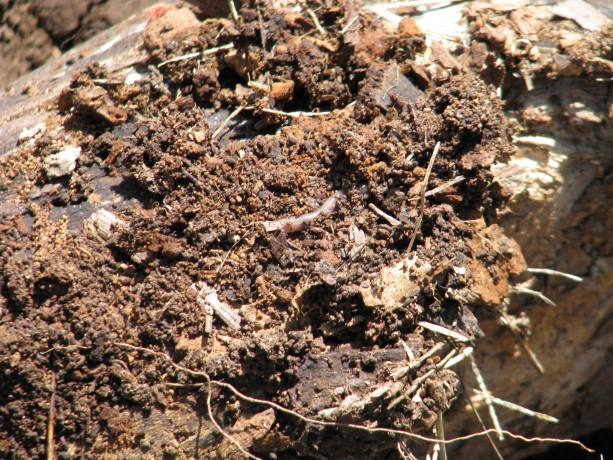
The activity under an old log shows so many visible decomposers, and there are thousands that we don’t see. We laid the wood into the trench.
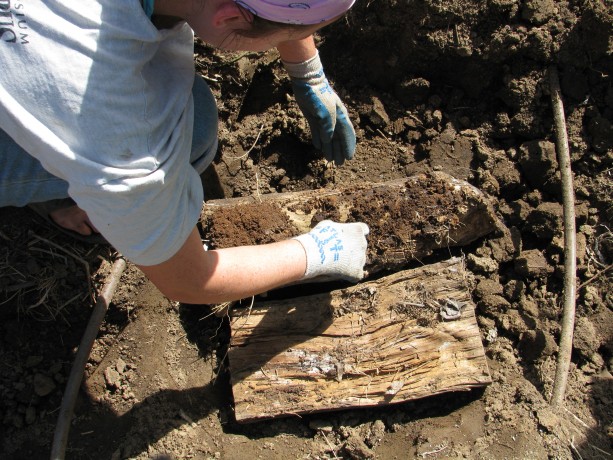
Placing old logs in the swale. If you don’t have old logs, what do you use? Everything else!
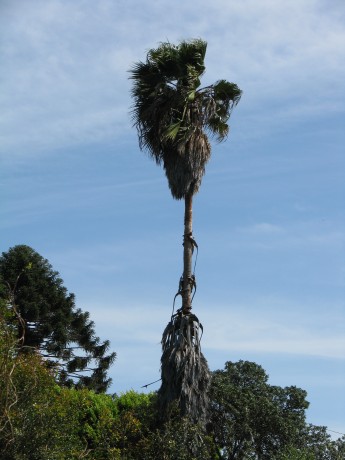
This giant palm has been a home to raccoons and orioles, and a perch for countless other birds. The last big wind storm distributed the fronds everywhere. We are wealthy in palm fronds.
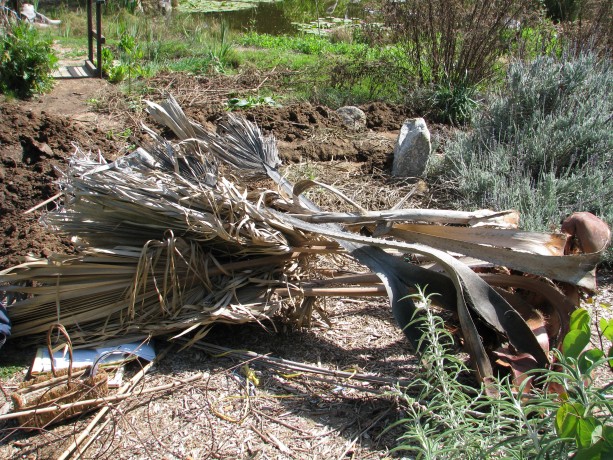
Three quick cuts (to fit the bed) made these thorny fronds perfect hugelbed components. We layered all sorts of cuttings with the clay soil, and watered it in, making sure the water flowed across the level swale.
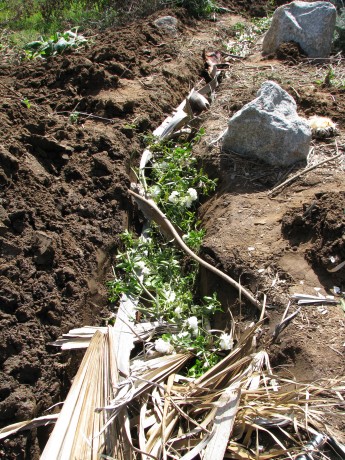
We filled the swale with fronds, rose and sage trimmings, some old firewood and sticks, and clay. As we worked, we felt as if we were being watched.
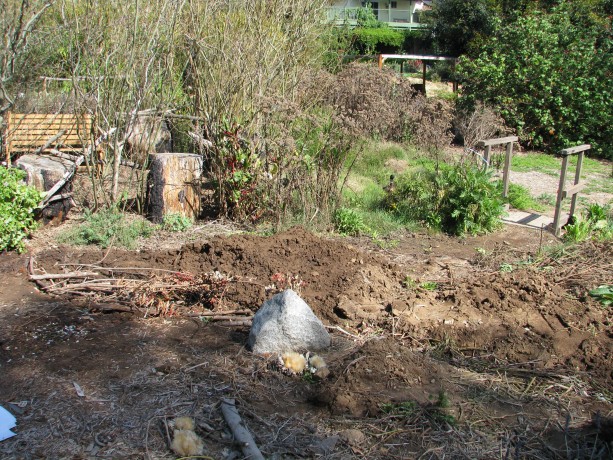
Can you spot the duck in this photo? Mr. and Mrs. Mallard were out for a graze, boldly checking out our progress. He is guarding her as she hikes around the property, leading him on a merry chase every afternoon. You can see Mr. Mallard to the left of the little bridge.
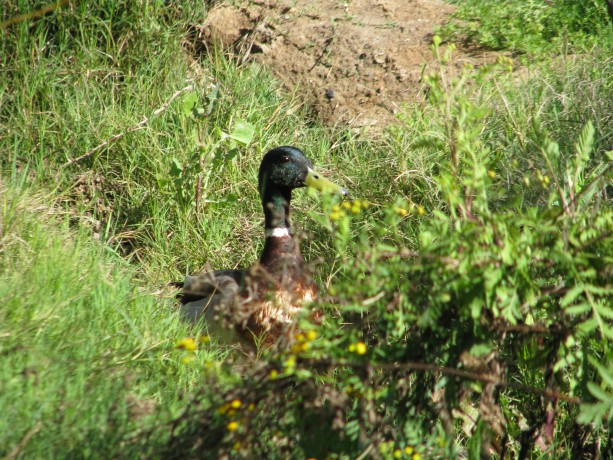
This male mallard and his mate, who is ‘ducked’ down in front of him, enjoyed grazing on weeds and watching we silly humans work so hard. After filling the swale, we covered the new trail that now transects the guild with cardboard to repress weeds.
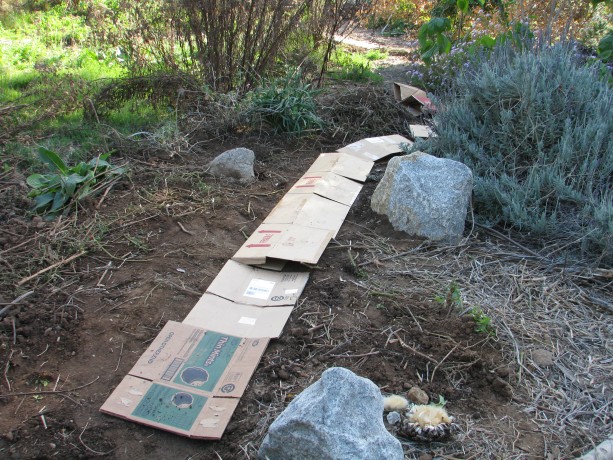
Cardboard laid over the hugelswale. Then we covered that with wood chips and delineated the pathway with sticks; visitors never seem to see the pathways and are always stepping into the guilds. Grrr!

The cardboard was covered with wood chips and the pathway delineated with sticks. Where the trail curves to the left is a small raised hugelbed to help hold back water. At this point the day – and we – were done, but a couple of days later we planted. Polyculture is the best answer to pest problems and more nutritional food. We chose different mixes of seeds for each of the quadrants, based on situation, neighbor plants, companion planting and shade. We kept in mind the ‘recipe’ for plant guilds, choosing a nitrogen-fixer, a deep tap-rooted plant, a shade plant, an insect attractor, and a trellis plant. So, for one quarter we mixed together seeds of carrot, radish, corn, a bush squash, leaf parsley and a wildflower. Another had eggplant, a short-vined melon (we’ll be building trellises for most of our larger vining plants), basil, Swiss chard, garlic, poppies, and fava beans. In the raised hugelbed I planted peas, carrots, and flower seeds.
In the back quadrant next to the mulberry I wanted to trellis tomatoes.
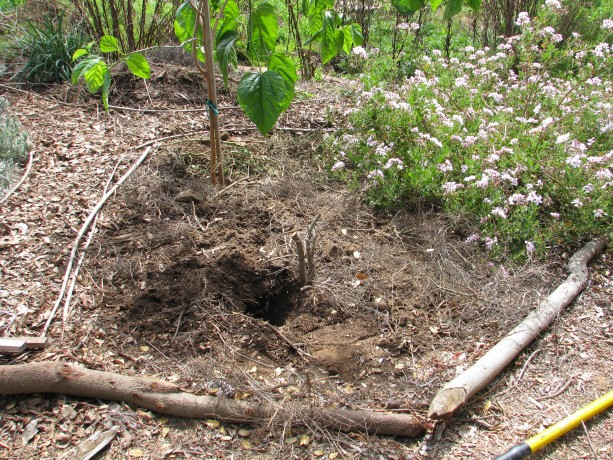
This quadrant by the mulberry needed a trellis for tomatoes. I’d coppiced some young volunteer oaks, using the trunks for mushroom inoculation, and kept the tops because they branched out and I thought maybe they’d come in handy. Sure enough, we decided to try one for a tomato trellis. Tomatoes love to vine up other plants. Some of ours made it about ten feet in the air, which made them hard to pick but gave us a lesson in vines and were amusing to regard. So we dug a hole and stuck in one of these cuttings, then hammered in stakes on either side and tied the whole thing up.
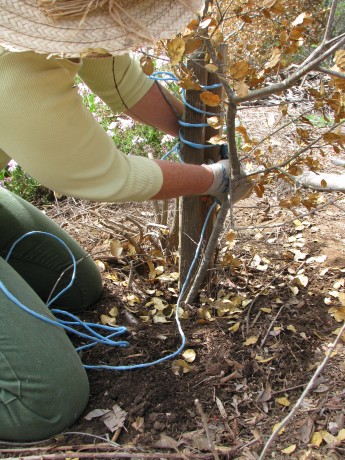
Tying the trunk to two stakes with twine taken from straw bales. Love the blue color! The result looks like a dead tree. However, the leaves will drop, providing good mulch, the tiny current tomatoes which we seeded around the trunk will enjoy the support of all the small twigs and branches, and will cascade down from the arched side.
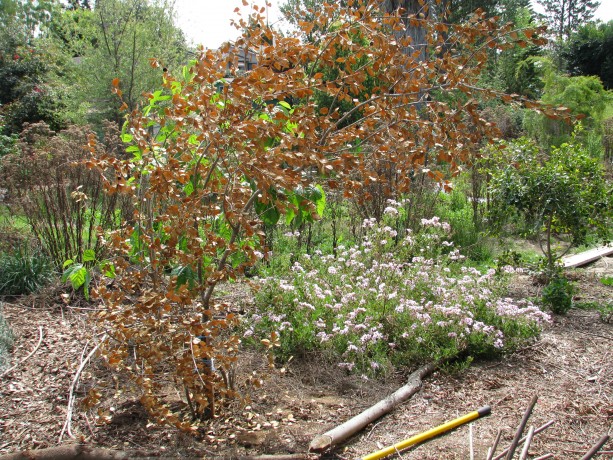
The ‘dead tree’ look won’t last long as the tomatoes climb over it and dangle close to the path for easy harvesting. We seeded the area with another kind of carrots (carrots love tomatoes!) and basil, and planted Tall Telephone beans around the mulberry trunk to use and protect it with vines. We watered it all in with well water, and can’t wait to see what pops up! We have so many new varieties from Baker Creek Heirloom Seeds and other sources that we’re planting this year! Today we move onto the next bed.
-
Why Finches Turn Red, and Other Interesting Animal Dating Facts
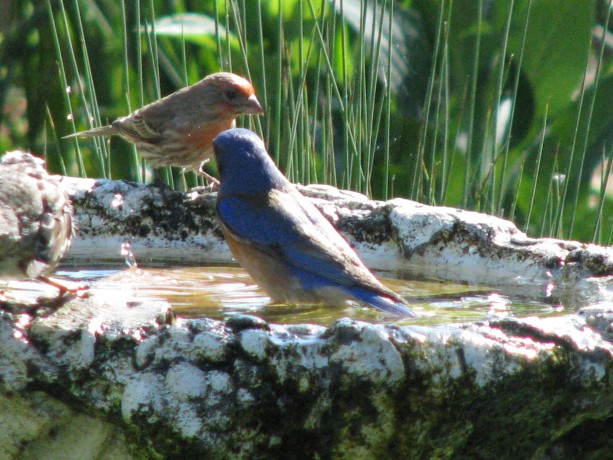
A male house finch and a male western bluebird just as mating season was kicking in. Spring is half-way through and many animals have already had their first batch of young; some are working on their second. Perhaps you noticed when some of the house finches turned a bright shade of red? In fact, many male animals look much differently than the females, becoming more brightly colored, larger, darker, or grow larger horns or antlers. This phenomena is called sexual dimorphism. This is a complicated topic when you begin to analyze all the different forms and shapes boys and girls of the animal kingdom take in order to keep their gene pool going. However I’m going to simplify it because it is pretty darn interesting.
Consider an animal; lets take a house finch. Their lives are spent finding food, finding a mate, finding lots more food for themselves and their young, and surviving predation, accidents and weather. There isn’t much time for playing around. The dawn chorus is the birds calling out that they survived another 24 hours and where is everyone else?
Consider animal calories as money. Finding food and surviving costs a lot of money/calories. For a male house finch to impress a female, they want to make sure they convey the message that they are better at finding food and more macho than the other males. This trait is essentially true for all polygamous (don’t mate for life) animals. (Let that be a lesson learned, girls!) In flocks or packs or herds that are open and often on the move, guys show their wealth through coloration, size and ornamentation. It takes more calories for the finch to turn colors, just like it takes lots of calories for peacocks to be larger and gaudier than females, or cape buffalo to be darker, or ungulates to grow really large horns. But why a brighter shade of red? The bright colors and larger size (in part) show that these males aren’t afraid of attracting the attention of predators because they are strong and macho enough to survive an attack. The darker the color, the more calories, the more fit and healthy, and thus the better food-gatherer and protector for the brood. The guys are saying, “Bring it on!”
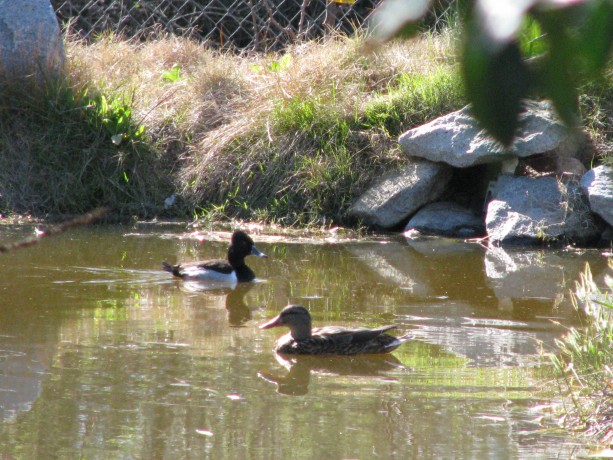
Mallard drakes are very colorful compared to the ducks. Females of these sexual dimorphic species are given a hard rap by being called dull-colored. What they are, of course, are smartly colored. They are camouflage to fit in with the area in which they will be nesting. They are thinking ahead. They don’t go in for dramatic courtship dances because they don’t have to: the guys are desperate for a healthy female to be attracted to them so that they can pass on their genes. It is a buyer’s market. Females also need to store calories because creating eggs or gestating and giving birth then feeding/producing milk and raising kids to maturity is very expensive. Isn’t it, though?
In closed herds or with animals who are monogamous (crows, for instance), the males don’t need to spend money on dates, so dressing up is just considered a waste of money/calories. (Does that sound familiar?).
As I mentioned, there are many variations on the whole sex thing, such as species where the females are larger than the males. Many spiders have this trait and it is supposed that in species who are solitary the females need to be large to be seen by the males, or to have the strength to carry young with them and feed them, and all the males need to spend calories on is, well, you know. Slam, bam, good-bye Ma’am, and all that. Until, of course, he is eaten by the female Black Widow spider. Or is murdered by the female worker bees. So it goes.
When you look out the window and see a brightly colored finch, or a large dark western fence lizard doing push-ups on a warm rock, or see deer with tremendous antlers (deer’s antler are shed every year, by the way. Antelopes have horns which are a one-time shot), you can appreciate how expensive it is for that male to put on such a show to attract a mate.
That pretty much is why we overspend on dates, too.
- Animals, Books, Breads, Chickens, Compost, Gardening adventures, Giving, Health, Humor, Permaculture and Edible Forest Gardening Adventures, Pets, Recipes, Reptiles and Amphibians, Soil, Vegetables
The Life of Di, or Fall At My House
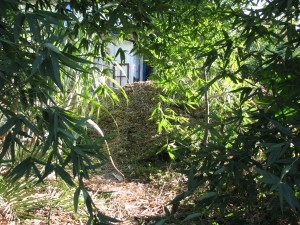
“And here’s another fine mess you’ve gotten me into!” I like to be involved with many projects at once. I picture my life as an opal, my birthstone, full of swirled colors and hues. I have several books going at once, projects chipped away at around the house, volunteer responsibilities strewn across my week, and far too many animals and acres to care for. When I’m exhausted I can spend a day on the couch reading with no trouble at all being the picture of laziness. Prior to Thanksgiving I underwent a skin cancer preventative treatment on my face and hands, which required applying a topical cream twice a day that brings suspicious cells to the surface and burns them off. By the end of the second week I was quite a mess, and then took another week to heal enough to be seen in public without alerting the zombie hunters. The treatment, needless to say, kept me from being in sunlight, therefore housebound. Always loving a clean, organized house but never actually completely cleaning or organizing, I figured I’d get some work done. I tried sorting about 15 boxes of photo albums left by my mother and grandmother… and got through one box before I had to stop. I wanted to bake bread, and I wanted to find something to do with the small amount of hops we harvested, so I experimented with a recipe that had a starter, sponge and rising that altogether took five days. The Turnipseed Sisters’ White Bread from the classic Bernard Clayton’s New Complete Book of Breads .

Turnipseed Sisters’ White Loaf starter made with hops. The starter really smelled like beer. Not in a pleasant way, either. However the bread was good, and baking was fun.

Good sandwich and toast bread. Just the extra carbs I needed for sitting on my butt for two weeks, right? Then I wanted to thin, clean and alphabetize the fiction section in my living room.

Books piled alphabetically… a little later there was a small avalanche. Yes, I have enough books in my house that they are in sections. Former school librarian and bookstore worker here. I haven’t done the non-fiction section as yet, which extends to most of the other rooms in the house. Maybe next year? I did a little writing, a lot of reading, surrounded by my elderly dog Sophie

Sophie enjoying good sleeps. who keeps returning from the brink of death to sleep about 23 hours a day, and one of my hens, Viola, who suddenly went lame in one leg.

Viola on a healing vacation. All advice was to cull her, but I thought that she pulled a muscle and hadn’t broken her leg, and being vegetarian I don’t eat my pets. Viola has been recuperating in a cage in the dining room, gaining strength in that leg, laying regular eggs, having full rein of the front yard, and crooning wonderfully. As I count wild birds for Cornell University’s Project Feederwatch, I keep an eye on the hen. The cats ignore her, thank goodness. I’ve quite enjoyed having a chicken in the house. Yep, I’m starting to be one of those kinds of aging ladies.
In between I’d spend time crawling under bushes to push and shove my 100-pound African spur thigh tortoise out of his hiding spot and into the heatlamp-warmed Rubbermaid house he shuns so that he wouldn’t catch cold in the chill damp nights. I always come out victorious, with him angry and begrudgingly warm, and with me wet, muddy, hair full of sticks and hands full of scratches. Does anyone have a life like this?
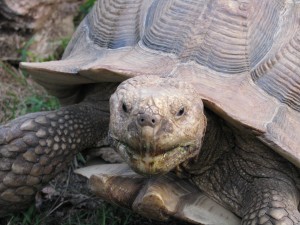
“I’m performing advanced trigonometry in my head, don’t bother me, Woman!” Finally my skin healed enough so that I was able to venture outdoors.
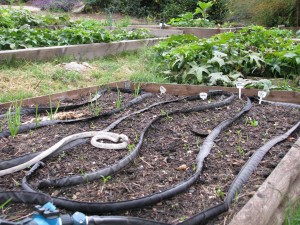
Garlic and seed sprouts guarded from birds by a rubber snake. I planted seeds of winter crops: collards, kale, garlic, onions, carrots, Brussels sprouts and broccoli rabe, and prepared raised beds for more.
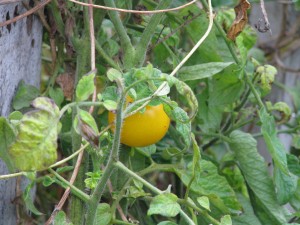
Yellow perfection tomatoes still ripening, as are the green zebra. I ordered organic pea, lupine and sweet pea seeds from Baker Creek Heirloom Seeds , all nitrogen-fixers to plant around the plant guilds.

Pepperoncini still producing. On Thanksgiving I hiked 1200 feet up Monserate Mountain in a record slow time; all that sitting and all that bread causing me to often stop and watch the slow holiday traffic on Hwy. 15, and be very glad that I was on a hike instead.
The neighbors had their annual tree butchering, paying exorbitant sums to have the same so-called landscapers come in and top their trees (shudder!) and thin others… for what reason I have no idea. Because being retired Orange County professionals they believe that trees need to be hacked back, contorted, and ruined? Possibly.
Please, please, please, friends don’t let friends top trees! Find an arborist who trims trees with an eye to their health and long-term growth and immediate beauty. A well-pruned tree is lovely, even just after pruning. A topped tree is brutal and ugly.

A topped coral tree. Ugh! Anyway, the upside is that I claimed all the chips, giving new life to the ravaged trees as mulch for my pathways. Two truckloads were delivered. I think I have enough for the whole property.
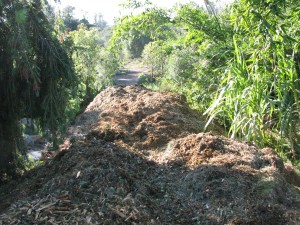
“The bear went over the mountain to see what he could see. He saw another mountain…” How to spread it? Yep, one wheelbarrow full at a time.
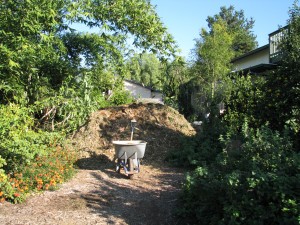
One wheelbarrow at a time. I can now condition myself for more hiking and weight lifting without leaving the property. The heaps have a lot of pine in them (they thinned the pine trees!???) so there is a pleasant Christmassy smell emanating from the heaps.
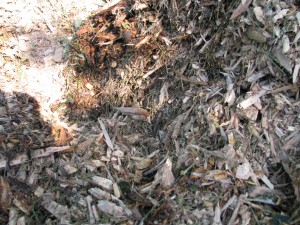
Hot steamy mulch. They are also very high nitrogen and were hot in the center on the second day and this morning were steaming right after our brief rain shower. Mulch piles can catch fire; when I worked for San Diego County Parks we rangers would joke about who had been called out by the fire department when their newly delivered mulch pile had caught fire in the night.
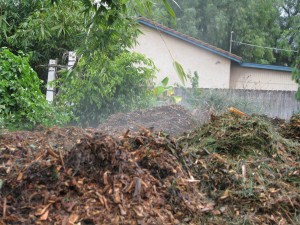
Steam from the mulch mountains. I stood on it just now and steam went up my pant legs and warmed me up! I also received a gift of seven 15-gallon nursery containers of llama poo!

The wealth of llama poo. Hot diggity! Early Christmas: My diamonds are round and brown, thank-you. I layered them in the compost heap and am ready for more.
I also wholeheartedly participated in Small Business Saturday, finding happy locals and crossing paths with friends and aquaintences at several stores. I received my first Merry Christmas from a man at Myrtle Creek Nursery’s parking lot as he waited for his son’s family to pick out a Christmas tree. I do love this town.
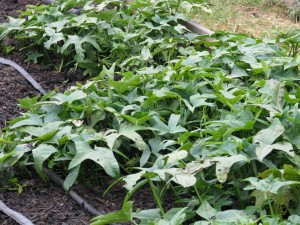
Sweet potatoes ready to harvest for Christmas dinner. That catches me up. Lots of projects, lots of volunteering, lots of cleaning up to do before my daughter comes home for the holidays and despairs at my bachelorette living. Lots of mulch to move. Lots of really great friends. Lots of sunscreen to wear. Lots to be thankful for.
- Animals, Bees, Birding, Gardening adventures, Other Insects, Permaculture and Edible Forest Gardening Adventures, Ponds, Reptiles and Amphibians, Soil, Worms
Fall Morning
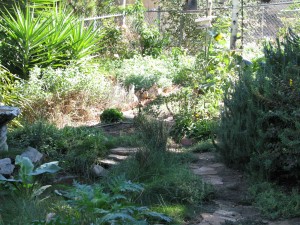
The birdwatching garden. I use the kitchen table as a work center, but spend a lot of time not working. That is because from the big dusty windowseat, through the spiderwebs that catch sunlight in the corners of the glass I watch a fairytale of animals. Song sparrows with their formal stripes and classy single black breast spot hop along the uneven flagstone walkway. The walkway, recently weeded, is again being compromised by sprouts. The small pond wears a heavy scarf of peppermint along its north side, and a mixture of fescues and waterplants around the south. A waterlily bravely floats pads on the still water after having been drastically thinned last month. A calla lily opens partially white, partially green.
Below the window in a dish of seed set low for ground feeders are house finches, the males’ proud red fading like the leaves of the Japanese maple behind the green bench. Lesser goldfinches skeletonize the leaves of sunflowers that have sprouted from birdseed; a nuthatch and a mountain chickadee take turns on the hanging suet feeder, both noisy and reminding me of pine forests. A pair of crows who have lived near this garden for years, but who have been about other business during the summer, are reunited on the telephone line. She grooms his feathers and he leans into her. I’ll have to put treats out for them, to keep on their good side. A Nutall’s woodpecker looks like a childhood toy by hopping straight up the big pine. I grin a welcome to a couple of white crowned sparrows, the forefront of the migratory flock. These spirited and chatty birds shuffle leaves onto my walkway every morning, and I quite happily sweep the leaves back for the next round. It is a ritual just between us. A young scrub jay swoops in with much show, seeing how big a reaction he can get from startling the smaller birds clustering at the feeders or taking warm dirtbaths. He lands on a small trellis and pecks out seeds from a sunflower I propped up after its yellow glory faded. Finches visit when he leaves and take their share of this high protein food.
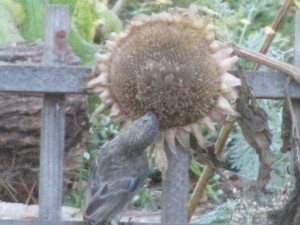
House finch nabbing sunflower seeds ( photo taken through a dirty window! Sorry!) The outside water is turned off; I should be on my knees in mud down by the chicken coop right now fixing a break in the pipe but I am held here by the autumnal light. Even in the morning it slants at a kinder angle, bringing out the gold in the leaves. Later when the water resumes the dripper on the bird bath will start and sparrows, finches, towhees and random visitors will sip drinks and take cleansing baths. One of my favorite sights is watching a group of finches taking turns in the bath, daring each other to stay longer and become wetter. Their splashing sends a cascade of drops into the sunlight. They give Finch Frolic its name. Now the only visitors are honeybees taking water to hydrate their honey. I emphathize with these bees. Only the older females do the pollen gathering, carrying heavy loads in their leg sacks back to the hive until they die in flight. A useful life, but a strenuous and unimaginative one.
Perhaps today there will also be a house sparrow, or a common yellowthroat or a disagreeable California towhee, what everyone knows as a ’round headed brown bird’. Or maybe the mockingbird will revisit the pyracantha berries, staking them out as his territory while finches steal them behind his back. I hear the wrentit’s bouncey-ball call, but as they can throw their voices I usually don’t spot them. Annas hummingbirds spend all their energy guarding the feeders, stopping to peer into the window to see if I’m a threat. My black cat Rosie O’Grady stares back, slowly hunching, mouth twitching with a soft kecking sound as if she could hunt through a window. I see that the hanging tray of grape jelly needs to be taken in and washed because the orioles have all migrated. Rosie is given up by the hummingbird and instead she watches cat TV as the birds shuffle in the Mexican primrose below the window.
I don’t see either of the bunnies this morning, Primrose or Clover. They live under the rosemary bush, and perhaps in the large pile of compost in the corner of the yard. I’ve watched them nibble the invasive Bermuda grass, and pull down stalks of weedy sow thistle and eat the flowers and seeds. They do no harm here, and are helping with the weeding; I love watching them lope around the pathways living in cautious peace.
Unseen by me by where I sit, mosquito fish, aquatic snails, dragonfly larvae, strange worms and small Pacific chorus frogs hang out in the pond and under the overhanging lips of flagstone I placed there just for them. Under the plants are Western fence lizards big and small awaiting warmth from the sun to heat up the rocks so they may climb the highest stone in their territory and posture while the heat quickens their blood. A mouse scurries between plants, capturing bits of birdseed scattered by the messy sparrows. The soil is good here, full of worms and microbes and fungus. Everything is full of life, if you only know how to look for it. You can smell it. You can feel it.
Now comes the spotted towhee, black headed with white patterns on his wings and reddish sides. Once called the rufous-sided towhee, he is bold and handsome, his call a long brash too-weeet. He sassily zig-zags down the narrow flagstone pathway looking for bugs.
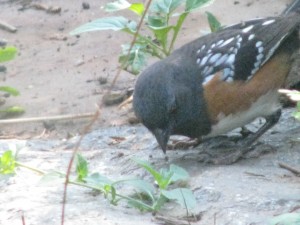
Spotted Towhee grubbing in his fancy clothes, so bright after a molt. I haven’t seen the rat family for a few days. The four youngsters invade the hanging feeders, tossing each other off and being juvenile delinquents. At night I hear the screech of a barn owl, which might be my answer.
The oxblood lilies – always a surprise during the dry and the heat of September, have almost all faded, but sprouts of paper white narcissus are beginning to break ground. They are Fall flowers here, usually done by Thanksgiving.
It is Fall. Finally. The world of my garden is tired and ready for a rest from the heat, the mating, the child rearing, the dryness, the search for diminishing food, the hiding so as not to become food. Although the days here are still in the high 80’s the evenings bring coolness and a much-needed dampness. Rain won’t come until November or later. But we wait for it, the animals, the plants and I. And time passes as I sit at the table and watch. I know of no better way to spend an autumn morning.
- Animals, Bees, Birding, Chickens, Compost, Gardening adventures, Health, Other Insects, Permaculture and Edible Forest Gardening Adventures, Photos, Ponds, Quail, Rain Catching, Reptiles and Amphibians, Soil
I Went to a Garden Party….

AAUW Garden Tour Saturday was the AAUW Garden Tour. What a glorious day. I expected about a hundred visitors, and made 120 handouts. Sometime in the early afternoon I guess they ran out, and I didn’t know about it for awhile. I made 25 more for the last two hours, and have five left. One of the docents said that some had been turned back in during the morning. Every couple probably took just one… wow, that’s a lot of people.
I’d been talking to the garden all week, asking the blooming plants to hold that thought for a few more days, and encouraging the nonblooming ones to get a move on. The plants did what I asked! There were so many flowers out Saturday, it was amazing. Heirloom roses, Gideon’s Trumpet, ranunculus, herbs, wildflowers, and waterlilies. The garden, apparently, also was also all for proof in advertising, as in standing behind the NWF Habitat sign on the front gate. So many kinds of butterflies and dragonflies were out for the first time this year that people remarked on it. In the afternoon, there were sightings of a king snake all over the property; I think it had to have been three kingsnakes. One was moved from the refreshment area, but he came back, and then as I was standing by the pond talking to some ladies one came past us. Another was sighted up in the driveway. Roger sighted a gopher snake. No one shrieked or complained; either these were hardy people, or the idea that this was a habitat yard made them keep calm. It also backed up my claims of letting snakes deal with gophers and rodents! One man spotted a baby bunny under the Withy Hide bench. By one o’clock, it was funny. It was as if a button had been pressed to turn the garden on, and all the features were working! What a glorious day.
Jacob (Aquascape Associates) and Roger (landscape architect) and I answered questions for most of the day; the last four visitors left at four. So many people asked questions about permaculture, soil, beekeeping, cob ovens and rain catchment that I know that I couldn’t answer everyone’s questions. Of course there were some who like a tidy, orderly garden, and that is fine. If everyone came away with some idea how to work with nature rather against it, to use chemicals less, to grow organic food, to repurpose, to compost their kitchen waste and weeds, then what a lot of small ripples of good will come of it.
Thank you to my dear friends who helped prepare the garden so that it looked stunning. And thank you to the snakes, butterflies, bees, dragonflies, birds, bunnies and who-knows-what-else that came out to perform for the visitors! And thank you to everyone who visited! No casualities; all good.
Here are some photos, although my camera doesn’t do the colors justice:
AAUW Garden Tour Welcome! Look at photos of how it was. Main entrance walkway Walkway into the Nest One of the many trails A palm sitting stump between guilds by the driveway A green melon under variegated lemon, with native grasses. Quail hut, with privacy boards up. Status and wildflowers across the stone walkway Cool spot under the upper pepper tree Roger and visitors by the Withy Hide Some of the first visitors of many Pickerel blooming in the little pond Gideon’s Trumpet keeping blooms and aroma until the tour Jacob teaching about natural ponds Baby bunny under the Withy Hide bench Roger answering questions View from the Bee Garden gate Cool spot under the pepper tree -
Kingsnake in the Pond
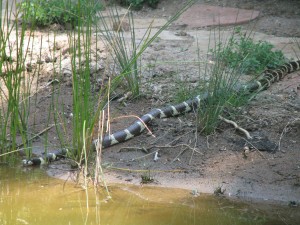
Coming down to the watering hole. With the AAUW Garden Tour coming up in three days (yikes!) and so much still to do, and of course working in the 80+ degree heat this week, I haven’t been doing much else. However the heat did bring out our annual visitor to the upper pond.
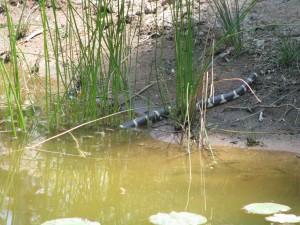
More than a drink... he's going in! He (or she) visits a couple of times a year, and seems to enjoy the new shape of the pond with its long shallow end.
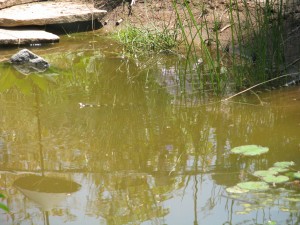
Swimming the channel. I wish he’d go after the bullfrog!
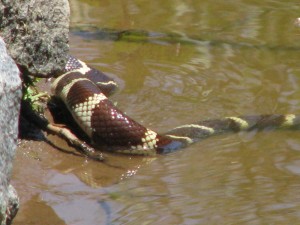
Beautiful bands. Siblings can be striped or banded. Kingsnakes are mild snakes that will eat other snakes, including rattlers. I’m glad to see him!
- Animals, Gardening adventures, Heirloom Plants, Permaculture and Edible Forest Gardening Adventures, Ponds, Reptiles and Amphibians, Soil, Vegetables
Earth Day at Finch Frolic
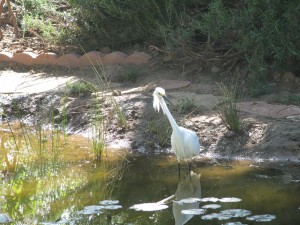
Snowy egret hunting. "Get the bullfrogs!" In celebration of Earth Day, I worked in the garden. You can stop laughing now. Yes, I know that I work in the garden nearly every day, and then spend time not volunteering or exercising, recovering from working in the garden. It was an overcast day, which beach-bound teenagers probably cursed, but I found perfect for working outside.

Roses in bloom everywhere. I had a visitor wishing me a Happy Earth Day.
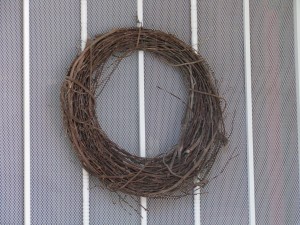
Do you notice anything about this wreath? This is an alligator lizard.
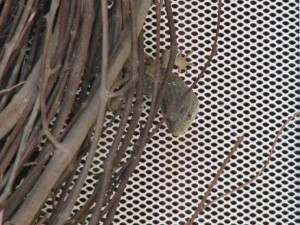
"Hello!" Hopefully he enjoyed the ride as I opened and closed the door several times to photograph him.
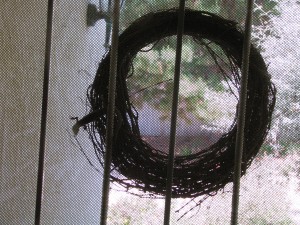
Alligator lizard from inside. Among other things today, I sifted compost. I had moved my compost bin, and this good compost was still on the ground from where it had been.
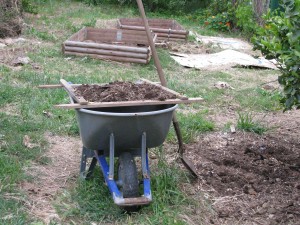
Sifting compost through a screen. I put it into a new raised (and wire-lined) bed.
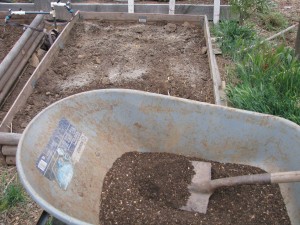
Adding sifted compost to the bed, which has been dusted with organic non-animal based fertilizer. Then I planted two rows of rice in it. Yes, rice. It is an heirloom variety from Baker Creek Organic Heirloom Seeds (http://rareseeds.com/rice-blue-bonnet.html), and it doesn’t need to stand in water to grow. Just something new and fun to try out.
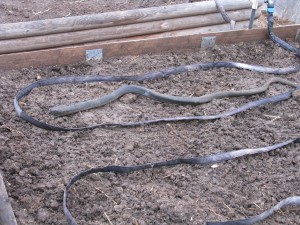
The rubber snake guards a freshly planted bed of rice. I’m also growing red seeded asparagus beans, the seeds of which were given to me by the woman who made the quail house. She also introduced me to Baker Creek, and for that I’m sincerely indebted. (http://rareseeds.com/red-seeded-asparagus-bean.html .)
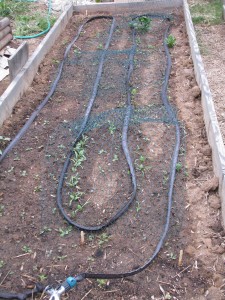
Spinach, carrots, edamame, sesame, Kentucky pole beans, endive and tomatoes are finally coming up. The other veggie beds are finally sprouting, now that the evenings have warmed up.
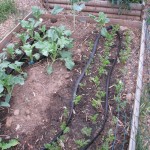
Collards and carrots, transplanted from another bed and doing well. 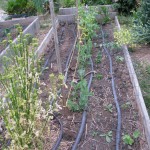
An incredible parsley setting seed, peas, parsnips, spinach, rhubarb, carrots and beans. 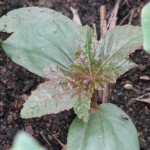
Castor bean seeds were in the mushroom compost, and I'm pulling them quickly. Here are a few views from other areas of the garden. Three weeds until the AAUW Garden Tour. Yikes!
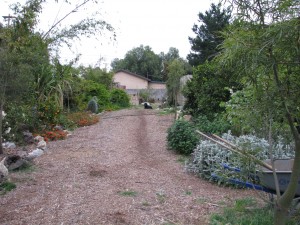
General Mischief waiting near the quail house for dinner. The hose connects to the 700 gallons of cootie water (compost tea) and is irrigating native plants. 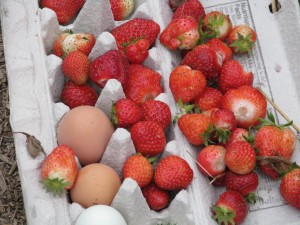
A happy harvest. Strawberries and eggs. I'm freezing the berries for later to make jam. 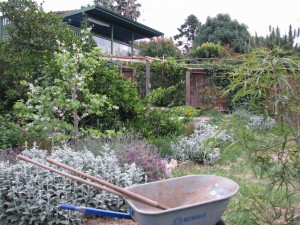
Lamb's Ear, whitebud, passionfruit and Bermuda grass 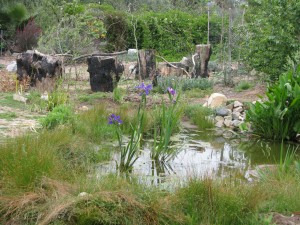
Stunning blue iris in the pond. 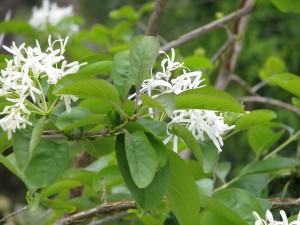
Fringe tree in bloom. 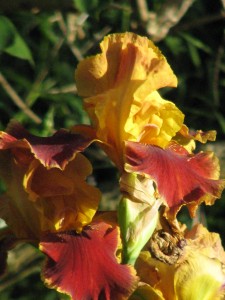
Iris


